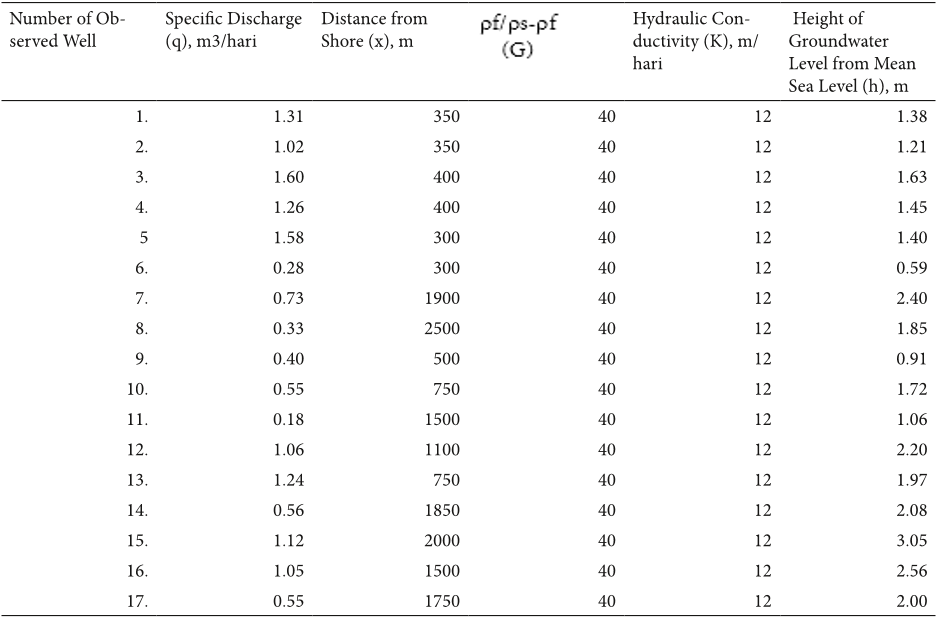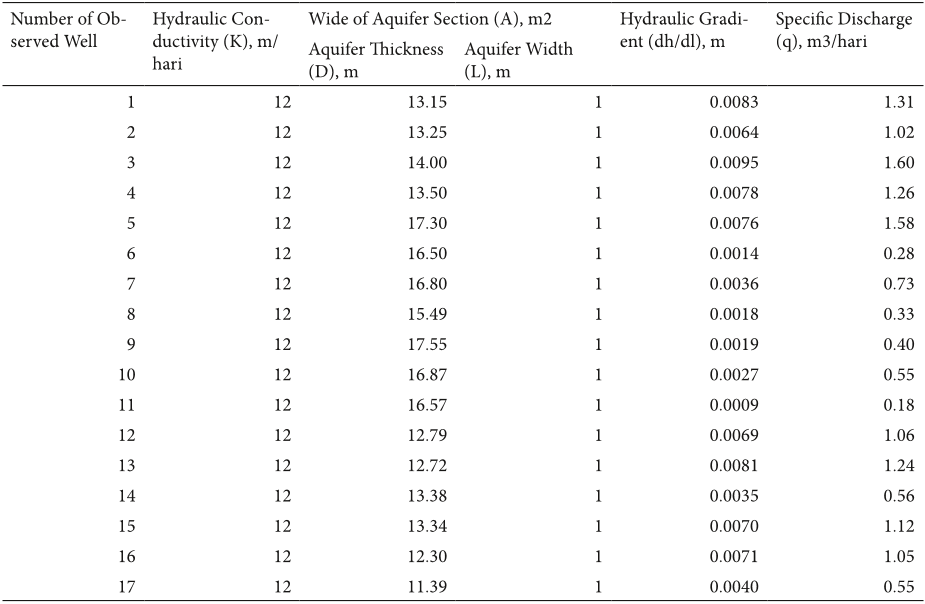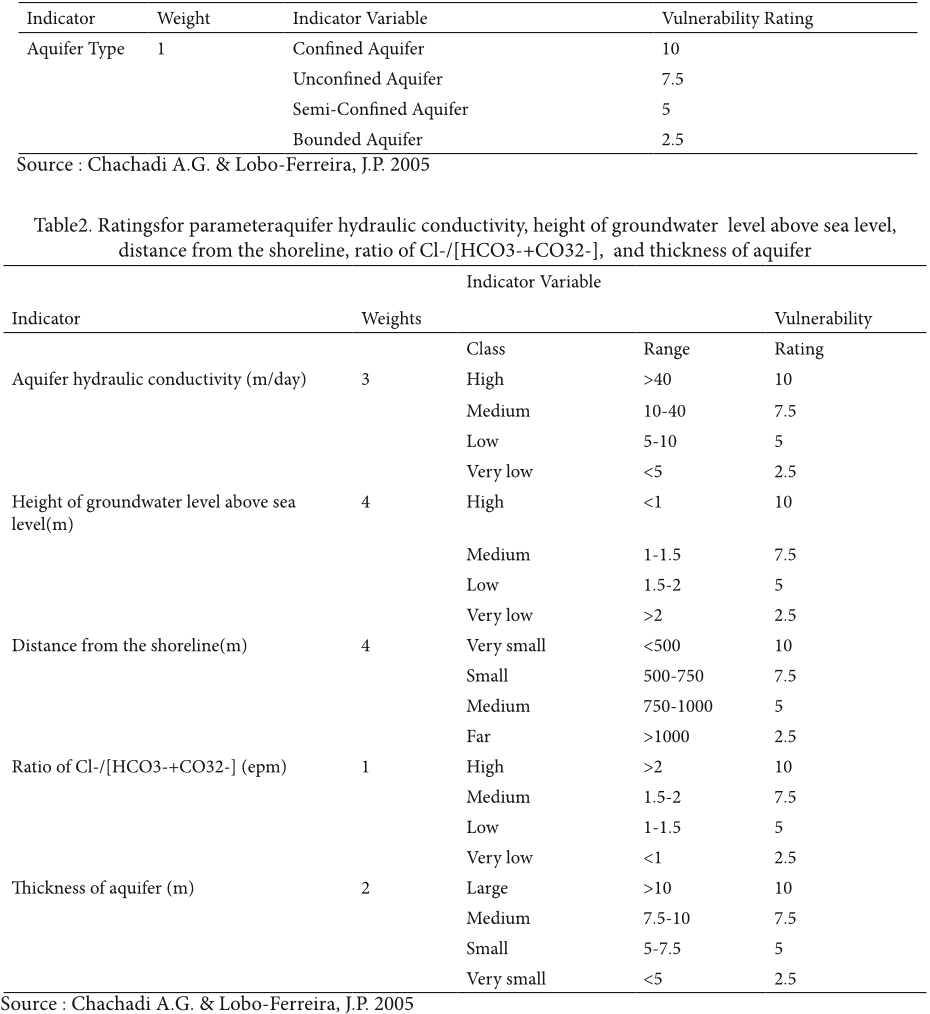
Groundwater Vulnerability from Sea Water Intrusion in Coastal Area
Cilacap, Indonesia
Setyawan Purnama
Faculty of Geography, Universitas Gadjah Mada, Yogyakarta, Indonesia
Abstract e important issue relating to water resources is sea water intrusion (SWI) phenome-
na. Nowadays, the phenomena has become serious problem in the urban coastal area. Ground-
water as main sources for domestic usage cannot be used again because of its salinity.Cilacap
as one of urban coastal area also face the problem. In 1977 SWIwas detectedand experienced
signicant developmentsin 1996,is research was conducted to: (1) analyze agroundwater vul-
nerability to the SWI; (2) determine adistance and adepth theinterface; and (3) analyze relation-
ship of the groundwater vulnerability to the interface depth.It was performed an analysis of the
groundwater vulnerability to the SWI using the method of GALDIT, whereas the distance and
depth of the interface was determined using the method of DupuitGhyben-Herzberg. e link-
age analysis of the groundwater vulnerability to the depth of the actual interface was conducted
by quantitative descriptively.e results showed that the distance from the shoreline was the
most determined factor of the groundwater vulnerability to the SWI, the closer to the shoreline
the more swallow the depth of the interface. It existed the relevance between the vulnerability
level of groundwater to the SWI with the depth of actual interface. e regions with low level of
vulnerability had deep interface depth, whereas the regions with moderate level of vulnerability
had swallow interface depth. Nevertheless, the SWI has not yet aected the groundwater in
people wells because of its depth that was not yet exceeded of 25 m.so that this depth can be used
as a reference in digging wells in the research area++
Received: 2019-05-18
Accepted: 2019-07-29
Keywords:
groundwater vulnerability,
sea water intrusion,
coastal city,
Cilacap,
Indonesia
Corespondent Email:
Igiwan@ugm.ac.id
1.Introduction
Coastal is a contact area between land and sea.
Towards the land covers parts of the land, both dry and
submerged in water, which are still inuenced by the
characteristics of the sea such as tides, sea breezes, and
SWI, while towards the sea covers the part of the sea
which is still inuenced by natural processes. Because
of this location, coastal areas are vulnerable to various
problems such as SWI and tidal ooding.
Partly citiesin Java, Indonesia are located incoastal
area, such as:Jakarta, Cirebon, Pekalongan, Semarang,
and Surabaya are some of cities located on the northern
coast of Java, whereas Cilacap is located on the southern
one of Java Island. In general, coastal zone oen face
intensive pressures for development (Gwalema, 2011).
Beside it, urban areas in the coastal area have faster rate
of growth than the rural ones, marked by higher level
of population growth and the expansion of residential
areas.A greater growing number of people needs more
facilities and infrastructure, one of them is water
resources availability. It would aect to the greater
number of groundwater extraction, whereas in another
side it would be decreased the groundwater inow
because of the larger open land used for recharge area
was converted into residential area (Tillman & Leake,
2010; Fenta & Kie, 2014; Waikar & Nilawar, 2014).
e decreased number of groundwater would
eect to the decreased number of water pressure that
could cause penetration of saline water from sea into
the mainland (Pousa, et al., 2007; Marandi & Vallner,
2010). is phenomenon is called sea water intrusion
(SWI), whereas border between freshwater and saline
water is called interface (Young Kim, Suk Park, & Pyo
Kim, 2009; Basack, Bhattacharya, Sahana, & Maity,
2010; Rotzoll, et al., 2010). Beside that, recently SWI
was also driven by future sea level rise which result
to the increase of the fresh water front forward move
(Rahmawati, Vullaume, & Purnama, 2013). It could
be said that the SWI is problematic issue in the cities
located on the coastal regions, because it could make
quality changes of groundwater that could not be use
more as drinking water resource (Obikoya, 2010; Dayal
& Chauhan, 2010).
Some researchresults showed that it has been
detected an interface in Cilacap City. It turned out over
time the depth of interface in some places of the city
was changed. In 1996 it was found the existence of SWI
in some places that were not detected with it in 1977
(Simoen, Darmanto, & Darsomartoyo, 1977; Purnama,
Perkembangan intrusi air laut di Kota Administratif
Cilacap., 1996). Nevertheless, some places with
interface in 1977 and 1996 were not detected anymore
with it in 2013 (Purnama, et al., 2013). Related to this
Indonesian Journal of Geography Vol. 51 No. 2, August 2019 (206 - 216)
DOI: http://dx.doi.org/10.22146/ijg.44914
© 2019 by the authors.is article is an open access article distributed under the terms and conditions of the Creative
Commons Attribution(CC BY NC) licensehttps://creativecommons.org/licenses/by-nc/4.0
RESEARCH ARTICLE

Indonesian Journal of Geography, Vol. 51 No. 2, August 2019 : 206 - 216
207
problem, it has been continued the research of SWI in
the coastal area of Cilacap to get actual information
about the eects of distance from the shoreline to the
depth of interface in the researcharea.
Base on the background, the objectives of the
research are (1) analyze the groundwater vulnerability
to the SWI in the research area, (2) determine the
distance and the depth of the interface in the research
area, and (3) analyze the relationship of the groundwater
vulnerability to the interface depth.
2.e Methods
To nd out the relationship between groundwater
vulnerability fromSWI and distance from shoreline and
interface depth two method were used, namely GALDIT
method and Dupuit Ghyben-Herzberg principle
With the GALDIT, it can be seen the environmental
condition of a place related to its vulnerability including
the distance from the shore line, whereas with the
Dupuit Ghyben-Herzberg, the depth of the interface
can be known at a certain distance on the shore line.
e GALDIT method has been successfully uses to
asses groundwater vulnerability from SWI in the
Portuguese aquifer system of Monte Gardo (Lobo-
Ferreira, Chachadi, Diamantino, & Henriques, 2005)
and the Bardez aquifer in Goa India (Chachadi & Lobo-
Ferreira, 2005).
Determination of Groundwater Vulnerability
It was conducted a research using GALDIT method
to get the information about groundwater vulnerability
fromSWI. GALDIT stands for parameters that can
cause sea water intrusion. G is dened as groundwater
occurrence, A is dened as aquifer hydraulic
conductivity, L is dened as level of groundwater above
mean sea level, D is distance from the shore, I as impact
of existing status of SWI and T is thickness of aquifer
being mapped (Chachadi & Lobo-Ferreira, 2005).
e basic principle of this method was
determination of vulnerability based on numerical
system in weight and rating. e weight was determined
based on the signicance of parameter inuence to SWI,
whereas rating was specied based on the signicancy
of variable eect of each parameter to the SWI. Weight
and rating of each GALDIT parameter and variable is
shown in Tables 1 and 2.
Determination of Distance and Interface Depth
eoritically, the groundwater ow in the coastal
aquifer could be explained through the combination of
Dupuit equation and Ghyben-Herzberg principle such
as the following (Fetter, 2001) :
z=Gq/K+√(2Gqx/K) ..…………................................(2)
by q is the specic discharge of groundwater per unit of
wide in m3/day/m, x is shoreline distance to the point
of the determined land and K is hydraulic conductivity
that determined by Morris and Johnson criteria (Todd
& Mays, 2005). e specic discharge of groundwater
could be calculated by using the method of Darcy
(Rushton, 2003; Davie, 2008):
q=K.A.dh/dl ……………......................................(3)
by dh/dl is hydraulic gradient.
e heigh of freatic level from sea water level in
each distance of x and the depth of z interface could be
determined using the following equation (Fetter, 2001) :
h=√(2qx/GK) ....….………...........................(4)
To validate the calculated results, it could be
conducted a measurement of electrical conductance in
the observed well. If the electrical conductance is less
than 1500 µmhos/cm, it could be said that the observed
well is not yet inuenced by the saline water. Likewise,
if the level of chloride is less than 150 mg/l, it could be
said for the same condition of the observed well.
3.Result and Discussion
Groundwater Vulnerability
As explained before, therewere six types of
parameters used to calculate the index of GALDIT i.e.
aquifer hydraulic conductivity, height of groundwater
level, distance from the shoreline, ratio of Cl-/ [HCO3-
+ CO32-], and thickness of aquifer. Because of the
dierent inuence of each parameters in saline water
intrusion, the weight was also dierent. For the aquifer
type the weight was 1, the aquifer hydraulic conductivity
was 3, height of groundwater level was 4, distance from
the shore was 4, the ratio of Cl-/[HCO3-+ CO32-] was
1, and for the aquifer thickness was 2.
Result determinant of rating of each parameter
indicated that based on the composition of rock
layering of the data drilling, there was only one types of
aquifers in the research area that is unconned aquifer,
so that the same value of the rating was 7.5. Related
to the aquifer constituent rocks, all of them have sand
textured so that the aquifer hydraulic conductivity was
also 7.5.
It was quite varied for the height of groundwater
level in the sea level. Nevertheless, almost all had
categories of more than 2 meters of mean sea level, so
that it valued of 2.5. Only one observed wells which
had the groundwater level between 1.5-2 m of mean sea
level and 5 in value.
It was estimated that the distance from the
shoreline was dominant parameter in determining the
groundwater vulnerability in the research area because
its value was quite varied, and it was similar for the
ratings. e results of rating determination showed
that the parameter of distance from the shoreline varied
from 2.5 to 10.
Giving attention to the ratio value of Cl-/[HCO3-
+ CO32-], it was known that the groundwater in
observed wells had value between 0.13 to 0.33. Based
on the rating of GALDIT index, the value range was
entered in one category and was valued by 2.5. It was
also existed for the parameters of the aquifer thickness
that ranged from 11.39 to 17.55 m. Based on the ratings

GROUNDWATER VULNERABILITY FROMSEA Setyawan Purnama
208
of GALDIT index, the range value was entered in one
category thickness level with the value of 10.
Furthermore, based on the ratings of each
parameter it could be calculated the GALDIT index
for each observed well. e calculations showed that
there were eight observed wells with the GALDIT index
of 4.8, two observed wells with the GALDIT index
of 5.5, and seven observed wells with the GALDIT
index of 6.8. Viewed from the vulnerability level,
eight observed wells were belonged to the level of low
vulnerability and nine observed wells were belonged
to the moderate vulnerability. It is regarded from
the spreading, generally the observed wells with the
moderate vulnerability level were located at the closer
distance from the shoreline, whereas the observed wells
with the low level of vulnerability were located further
away from the shoreline. Based on this data (Table 4),
it could be created a Groundwater Vulnerability Map of
saline water intrusion in the research area as shown in
Figure 1.
Table2. Ratingsfor parameteraquifer hydraulic conductivity, height of groundwater level above sea level,
distance from the shoreline, ratio of Cl-/[HCO3-+CO32-], and thickness of aquifer
Indicator Variable
Indicator Weights Vulnerability
Class Range Rating
Aquifer hydraulic conductivity (m/day) 3 High >40 10
Medium 10-40 7.5
Low 5-10 5
Very low <5 2.5
Height of groundwater level above sea
level(m)
4 High <1 10
Medium 1-1.5 7.5
Low 1.5-2 5
Very low >2 2.5
Distance from the shoreline(m) 4 Very small <500 10
Small 500-750 7.5
Medium 750-1000 5
Far >1000 2.5
Ratio of Cl-/[HCO3-+CO32-] (epm) 1 High >2 10
Medium 1.5-2 7.5
Low 1-1.5 5
Very low <1 2.5
ickness of aquifer (m) 2 Large >10 10
Medium 7.5-10 7.5
Small 5-7.5 5
Very small <5 2.5
Source : Chachadi A.G. & Lobo-Ferreira, J.P. 2005
Table 1. Rating forparameter aquifer type
Indicator Weight Indicator Variable Vulnerability Rating
Aquifer Type 1 Conned Aquifer 10
Unconned Aquifer 7.5
Semi-Conned Aquifer 5
Bounded Aquifer 2.5
Source : Chachadi A.G. & Lobo-Ferreira, J.P. 2005
Table3. GALDIT vulnerability classes
Index Range of GALDIT Vulnerability Classes
>7.5 High vulnerability
5-7.5 Moderate vulnerability
<5 Low vulnerability
Source : (Chachadi & Lobo-Ferreira, 2005)

Indonesian Journal of Geography, Vol. 51 No. 2, August 2019 : 206 - 216
209
Table 4. Calculation of GALDIT index and vulnerability classes
Number of
Observed
Well
Aquifer Type
Hydraulic Conductivity Height of Groundwater
Level
Distance from the Shore Ratio of Cl-/[HCO3-
+CO32-]
Aquifer ick-
ness
Index of
GALDIT
Vulner-
ability
Classes
Rating Weight Value Rating Weight Value Rating Weight Value Rating Weight Value Rating Weight Value Rating Weight Value
1 7.5 1 7.5 7.5 3 22.5 2.5 4 10 10 4 40 2.5 1 2.5 10 2 20 6.8 Moderate
2 7.5 1 7.5 7.5 3 22.5 2.5 4 10 10 4 40 2.5 1 2.5 10 2 20 6.8 Moderate
3 7.5 1 7.5 7.5 3 22.5 2.5 4 10 10 4 40 2.5 1 2.5 10 2 20 6.8 Moderate
4 7.5 1 7.5 7.5 3 22.5 2.5 4 10 10 4 40 2.5 1 2.5 10 2 20 6.8 Moderate
5 7.5 1 7.5 7.5 3 22.5 2.5 4 10 10 4 40 2.5 1 2.5 10 2 20 6.8 Moderate
6 7.5 1 7.5 7.5 3 22.5 2.5 4 10 10 4 40 2.5 1 2.5 10 2 20 6.8 Moderate
7 7.5 1 7.5 7.5 3 22.5 2.5 4 10 2,5 4 10 2.5 1 2.5 10 2 20 4.8 Low
8 7.5 1 7.5 7.5 3 22.5 2.5 4 10 2,5 4 10 2.5 1 2.5 10 2 20 4.8 Low
9 7.5 1 7.5 7.5 3 22.5 5.0 4 20 7,5 4 30 2.5 1 2.5 10 2 20 6.8 Moderate
10 7.5 1 7.5 7.5 3 22.5 2.5 4 10 5,0 4 20 2.5 1 2.5 10 2 20 5.5 Moderate
11 7.5 1 7.5 7.5 3 22.5 2.5 4 10 2,5 4 10 2.5 1 2.5 10 2 20 4.8 Low
12 7.5 1 7.5 7.5 3 22.5 2.5 4 10 2,5 4 10 2.5 1 2.5 10 2 20 4.8 Low
13 7.5 1 7.5 7.5 3 22.5 2.5 4 10 5,0 4 20 2.5 1 2.5 10 2 20 5.5 Moderate
14 7.5 1 7.5 7.5 3 22.5 2.5 4 10 2,5 4 10 2.5 1 2.5 10 2 20 4.8 Low
15 7.5 1 7.5 7.5 3 22.5 2.5 4 10 2,5 4 10 2.5 1 2.5 10 2 20 4.8 Low
16 75 1 7.5 7.5 3 22.5 2.5 4 10 2,5 4 10 2.5 1 2.5 10 2 20 4.8 Low
17 7.5 1 7.5 7.5 3 22.5 2.5 4 10 2,5 4 10 2.5 1 2.5 10 2 20 4.8 Low

GROUNDWATER VULNERABILITY FROMSEA Setyawan Purnama
210
Regarding to the Groundwater Vulnerability Map
of saline water intrusion that is shown in Figure 1, it
could be said that the distance from the shoreline
was the most determined factor of the groundwater
vulnerability to the saline water intrusion in Cilacap
coastal area. e closer area to the shoreline has a
higher vulnerability to the saline water intrusion than
the farther area.
Calculation of Specic Discharge
In this research, it was conducted the calculation
of specic discharge at all observed wells in accordance
with the path of groundwater ow in the ownet. Such
as explained in research methods, the equations used in
the calculation was the general equation of groundwater
ow from Darcy.
In accordance with this equation, calculation of
groundwater specic discharge needed some data i.e.
aquifer hydraulic conductivity, aquifer cross-sectional
area, and hydraulic gradient. e value of aquifer
hydraulic conductivity is determined based on drilling
data, which are located closest to the observed wells.
In the area of research there are three data drillings
i.e. villages of Cilacap, Sidanegara, and Tambakreja.
Considering to the constituent material of the aquifer,
the three sites of drilling are composed of sand with
varied colors i.e. brown and yellow sand at the top,
and black and gray sand on the bottom. Based on the
Morris and Johnson criteria (Todd & Mays, 2005), the
hydraulic conductivity value of sand is 12 m/day.
Figure 1. Groundwater Vulnerability Map fromSWI in the research area





